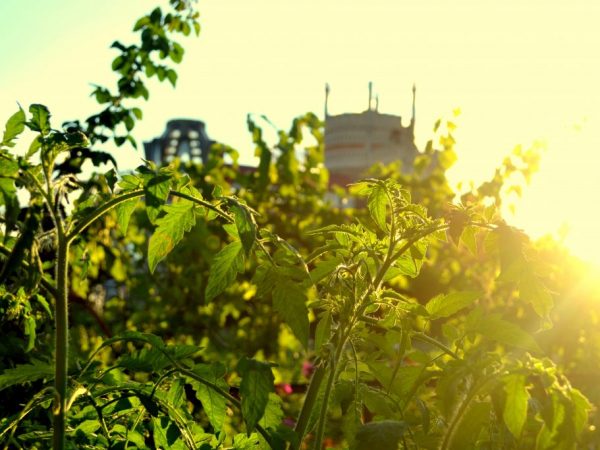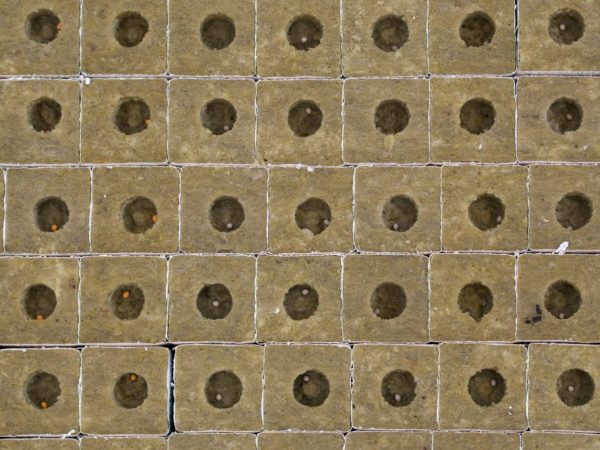Description of Sprut tomatoes
The Octopus tomato was bred relatively recently, but has already managed to interest many fans of unusual varieties. It can be grown outdoors or in a greenhouse, depending on the technology used. Tomato Octopus f1 has a number of interesting differences from other varieties of this vegetable crop. He has a huge, branching bush, high yields and two different growing methods. This variety is suitable for both beginners and experienced gardeners who want to try unusual options.

Description of Sprut tomatoes
Characteristics of the Octopus tomato
The first thing that the owner of the site should take into account is that only the first generation Octopus tomato seeds are suitable for planting, so you need to purchase seed material labeled "Octopus Tomatoes f1" or another similar type. You can try to get seeds from the harvested fruits, but in this case the resulting plants will not have the desired properties. The bushes will resemble the Cherry variety, or classic cream, but not the Octopus f1 tomato. Seedlings can only be grown from the first generation planting material.
In the reviews and descriptions of this variety, you can find the following name: tomato tree Octopus f1. If you grow this variety with the right technology, the size of the bush will really reach the size of a small tree. In this case, the total mass of the harvested fruits will reach 1-1.5 tons. Such results can be obtained only in a greenhouse if the bush is grown for a year and a half. For those who grow the Octopus tomato variety, there are two main technologies to choose from.
Plant care
There are several basic rules for caring for Octopus tomatoes. Firstly, only lukewarm water is suitable for watering them: because of the cold, it begins to hurt. Secondly, this plant practically does not need to remove stepchildren. Thirdly, due to unlimited growth, he needs constant feeding. Another plant must not be forgotten to limit its growth, otherwise it can grow up to 4-5 m in height. All this must be taken into account regardless of where the cultivation takes place: in a greenhouse or outdoors.
The resistance to pests and diseases of the variety is low. Although the tomato is called a tree, the f1 Octopus does not have the same immunity as tree plants. On the site, he will need additional protection from pests and fungi, in particular, late blight.
Tomato Octopus f1, if you look at the description, refers to tropical plants - it is harmed by the cold and lack of sunlight. He loves humidity, warmth and plenty of sunlight. All this must be provided to obtain a normal harvest.
Greenhouse cultivation
Growing an Octopus tomato in a greenhouse is the method that most attracts land owners. Here one point must be taken into account right away: such a technique is not cheap. It's all about the thermophilicity of this tomato.If you read reviews about the Octopus f1 tomato, it turns out that you need to keep the temperature in the greenhouse at 18-20 ° C all year round. Lighting is required with fluorescent lamps, 12 hours a day. And this is not the only problem.
The yield of one bush is high, but only if it is provided with the necessary area for further growth. The height of the greenhouse should be at least 4 m. In this case, one overgrown bush occupies 40-50 square meters. m of space, so many reviews of the productive variety of Octopus tomato claim that it is profitable to grow it in a greenhouse only in the southern regions. In the middle lane, it is better to get seedlings from seeds and plant them in open ground.
Creating suitable greenhouse conditions
This method can be called an economy only in terms of seedling consumption. The rest of the greenhouse will have to meet certain requirements for equipment and appearance. The main characteristic is this: the room should be suitable for a thermophilic plant that needs year-round sunshine, moisture and warmth. If it is not possible to prepare such a room, it is better to abandon this method. Here is what Octopus tomatoes need to grow in a greenhouse:
- Constant heating and equipment of the room with sufficiently strong light sources. It is not only the greenhouse itself that needs to be heated. It is necessary to control the temperature of the nutrient hydroponic solution.
- Landing capacity from 0.5 to 1.5 sq. m. Its height must be at least 50 cm, and the base area must be at least 1 m. Before use, the container must be cleaned and checked for leaks. The container will need a tight lid. It will help prevent overheating or contamination of the nutrient solution.
- Aquarium compressors will be required to ensure proper plant maintenance. The solution will not have enough air for the tomatoes. The plant will provide them with compressors, enriching the liquid.
- Devices for room and solution temperature control. For hydroponic cultivation, an air temperature of 18-22 ° C and a liquid temperature of 18-25 ° C will be required. This is necessary in order to avoid overheating in the warm season and freezing during cold weather.
Some gardeners are interested in what kind of soil can be suitable for greenhouse growing a tomato tree. And here it is immediately necessary to clarify: the bush can grow to the desired size only in a landless hydroponic solution. Here you need to choose a suitable substrate, prepare a mixture and a hydroponic installation, which you can assemble yourself or purchase ready-made. There are several points to pay attention to when growing a tomato tree this way.
Substrate preparation

Mineral wool will be an excellent growing substrate
For growing Octopus tomato, various options for hydroponic installations are used. But do not describe all the variations, it is better to focus on the main points. The installation must be equipped with a device for controlling the temperature of the solution. In winter, it should not be lower than 18-19 ° C. In summer, it should not be heated more than 23-24 ° C, then you need to think about choosing a substrate for the plant.
The reviews say that mineral wool is perfect as a substrate. It should be cut into 0.2 x 0.2 m cubes, placing the seeds in the middle of each cube. Expanded clay or coconut substrate can be used as a substitute for mineral wool. You can still get by with glass wool, but it is not always convenient to use it. After choosing a substrate, you need to prepare a nutrient mixture for growing. Here is one of the options that experienced greenhouse owners recommend:
- ammonium nitrate - 200 g;
- superphosphate or similar fertilizer - 500-600 g;
- magnesium sulfate - 300-350 g;
- potassium sulfate - 500 g (or potassium magnesium - 700-750 g);
- manganese sulfate - 2-3 g;
- boric acid - 3-4 g;
- iron citrate - 9-10 g.
Tomato tree care
To prepare the solution, you will need 10 liters of water. The dissolving water should be at room temperature. Before pouring into the hydroponic container, the solution must be cooled or heated to the desired level. When growing an Octopus tomato, you can use ready-made hydroponic mixtures. For proper plant care, the mixture must be topped up regularly so that it can receive all the necessary nutrients. It is necessary to plant seeds in August or September so that the tree has time to develop enough during the fall and winter.
There are certain rules for caring for tomatoes of the indeterminate variety Sprut f1. Firstly, in a greenhouse, they should not bear fruit for 7-8 months after planting. Not a single fruit should be on the bush; all ovaries must be cut off. The stems must grow continuously. You will need a trellis and a net under the ceiling to hold the crown of the tomato tree. The first fruit should appear no earlier than 9 months after planting the seeds. If proper care has been provided, over the next six months, it will be possible to harvest 900-1000 kg of tomatoes.
Outdoor cultivation
Such cultivation is not much different from planting other tomato hybrids. First, you need to purchase the Sprut f1 seeds (the name should contain the Latin f, not the Russian f). Planting seedlings will require light soil with a neutral acidity level. You can purchase or assemble it yourself. But in the second case, the collected soil must be disinfected, for example, by calcining in a furnace or oven. You can fertilize the soil only with mineral fertilizers. Tomatoes will need phosphorus, potassium and a small amount of nitrogen.
Seeds for seedlings should be planted at the end of the first or beginning of the second decade of February. The future harvest depends on what the seedlings will be. If the plants are weak or grow poorly, they should be fed every 2 weeks. In the case when the seedlings are tall and strong, you can only do with watering. It is necessary to plant bushes in the soil in a well-lit space at a distance of 1.5-2 m from each other. For growth, tomatoes of the Sprut variety require constant watering with lukewarm water.
Fertilizer for tomato Sprut
When planted outdoors, plants may require additional nitrogen fertilization. After flowering, weak potassium and phosphorus-based fertilizing can be applied to the soil to increase future yield. The plants themselves must be tied up so that the fruit does not lie on the ground. The bushes bear fruit before the first frost, so in the southern regions it is possible to collect up to 15 or more kilograms of tomatoes from one bush.
Here is what experienced gardeners write about the quality of the harvest:
“The weight and taste of the Octopus tomatoes are quite good. This applies to both greenhouse trees and shrubs planted in the open field. The mass of one fruit ranges from 100 to 200 g. Fruits grow in clusters on all shoots, which, by the way, do not require pinching. Tomatoes are very tasty, can be stored for a long time and are suitable for any use, therefore the variety is considered equally suitable both for growing for sale and for own use. "
Summarizing
The Octopus tomato variety is a unique hybrid. It has many interesting properties and is suitable for both beginners and experienced farmers. When grown hydroponically, a unique tomato tree is obtained, capable of producing record yields from a single bush. And when planting in open ground, the summer resident receives a fruitful and unpretentious plant, which is easy to care for. Do not forget about the high quality of the harvested crop.


